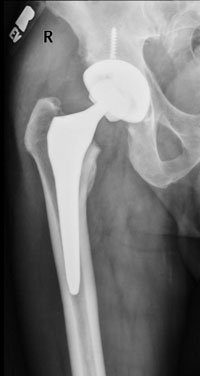Surgeons debate benefits of robotic-guided navigation for hip arthroplasty
In a recent crossfire debate, Douglas E. Padgett, MD, argued that orthopedists should use robotic-guided navigation during total hip replacement to ensure accurate component positioning. But, Michael E. Berend, MD, countered that too many questions about the technology remain for widespread use including efficacy, time, cost and potential risks.
“We need to currently use available technology,” Padgett said during the debate at the Current Concepts in Joint Replacement Winter 2011 Meeting in Orlando, Fla. “I think total hip should certainly enter its own new information age, and enhanced technology will allow us to customize hip arthroplasty for each one of our patients.”
Advantages of the technology
Robotic arm-guided total hip arthroplasty (THA) would increase accuracy during component positioning, Padgett said. In a study of 2,000 conventional THAs performed at Massachusetts General Hospital, Padgett and colleagues found that 50% of cups were positioned within the acceptable ranges of 25° anteversion and 40° abduction.
“[Robotics] combine the visual guidance afforded by navigation with the tactile feedback of robotics,” he said. “It is a semi-passive or haptic technology relying on touch defining the boundaries.”
|
Image: Padgett DE |
Using robotic arm-guided THA technology enhances preoperative planning and bone preparation, and provides reproducible implant positioning, leg length and offset, Padgett said.
“Despite beating on it with a 20-pound mallet, consistent orientation, both abduction and anteversion, are obtained,” he said. “We know exactly where the hip is going to wind up.”
Consider the complexity of THAs
The complexity of THA must be considered before using robotic arm-guided technology, Berend argued. The surgical approach, head size and patient factors, such as range of motion, must be considered before implementing robotics to place the cup in a certain predetermined position.
Events such as limb-length discrepancy, loosening, heterotopic ossification, impingement and dislocation may still occur in well-aligned components, Berend said. In a study of 3,379 conventional THAs, Berend and colleagues found three dislocations when the anterolateral approach (861 hips) was used and one dislocation when a posterior approach (40 hips) was used in combination with a femoral head size greater than 36 mm.
“Out of these hips, five patients may have benefitted from robotic technology,” Berend said.
However, it has been hypothesized that new technology may increase the opportunity for the treatment of early forms of arthritis in a growing population.
Berend said, “Robotics does not change the surgical indications for any hip or knee procedure.”
The financial investments needed for robotics are difficult to justify, Berend said. With an estimated 200 THAs performed at many orthopedic practices, it may be difficult to glean those who would benefit from robotics procedures, he added. The capital investment may approach $1 million dollars, with an additional $1,000 per case for the CT scan and interpretation along with up to $1,000 for disposables, Berend said.
“With health care reform upon us, all the appropriate investment in technology with our limited resources, is yet unresolved,” Berend said. “We need to approach efficiency and cost investment appropriately.”
Although many argue that using robotics improves outcomes, operating room efficiency and patient outcomes, Berend said that the evidence of these results are lacking. Concerns also exist about the use of robotics, including longer operative time, higher risk of heterotopic ossification and blood loss.
In addition, he noted that orthopedists can use the direct anterior approach to the hip and fluoroscopy to directly visualize component alignment without the use of robotics in less than 10 seconds during which “Leg lengths can be assessed intraoperatively,” Berend added.
“Innovation must be worth the time and expense,” Berend said. “As we know, the outcomes from total hips are linked to the indications of the procedure and many other variables. We need cost-effective, time-efficient technologies that are transferable from surgeon to surgeon, and importantly, from surgeon to patient.” – by Renee Blisard
References:
- Padgett DE, Berend ME. Robotic arm guided THA: Makin’ men out of boys! Papers #23 and #24. Presented at the Current Concepts in Joint Replacement Winter 2011 Meeting. Dec. 7-10. Orlando, Fla.
- Krenzel BA, Berend ME, Malinzak RA, et al. High preoperative range of motion is a significant risk factor for dislocation in primary total hip arthroplasty. J Arthroplasty. 2010; 25(6):31-35.
- Padgett DE. Hendrix SL, Mologne TS. Effectiveness of an acetabular positioning device in primary total hip arthroplasty. HHS J. 2005;1(1):64-67.

- Douglas E. Padgett, MD, can be reached at Hospital for Special Surgery, 535 E. 70th St., New York, NY 10021; 212-606-1642; email: padgettd@hss.edu.
- Michael E. Berend, MD, can be reached at Center for Hip & Knee Surgery, 1199 Hadley Rd., Mooresville, IN 46158; 317-831-2273; email: mikeberend@hotmail.com.
- Disclosures: Padgett is a consultant for MAKO Surgical Corp. and Stryker Orthopaedics. Berend receives royalties for intellectual property from Biomet Orthopedics and stock options for intellectual property from OrthoAlign Inc.






